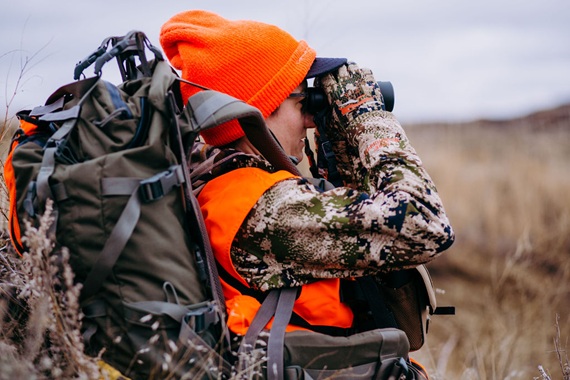Choosing the right gear is key to a successful hunt, and one of the most important pieces is your pack. It doesn’t matter if you’re out for a day trip or tracking game for several days, having a well-designed backpack can make or break your experience. It needs to carry your gear efficiently, keep you comfortable, and perform well in rugged environments.
Frame type

The most important feature of this hunting essential is the frame type and structure. It will have a big influence on your comfort and mobility. It’ll also determine how easily you can carry heavy loads. There are two main frame options: internal and external.
The internal ones sit closer to your body and are more compact. Because of this, they give you better balance and you can move with ease. If you’re going through bushy fields or steep terrain, or you’re going on a fast-paced hunt, this is the right frame for you. A good, reliable, high-quality hunting backpack with a sturdy internal frame will get you through the hard road.
On the other hand, if you’re carrying bulky gear or some heavy game meat, an external frame is perfect for the job. These frames are rigid and oftentimes adjustable. Because of their positioning, they offer better airflow between your back and the backpack, keeping you cool on long trips.
Size and Capacity
Not all hunts and hunters need the same amount of gear. So, matching the type of your trip with the size of your backpack is crucial. This capacity is measured in liters. A 20-35 L is good for day hunts where you just need the essentials such as water, ammo, snacks, a few tools, and a first aid kit.
For overnight trips or two-day hunts, a 40-60 L one will suffice. It has extra space for your food, shelter and clothing. Anything with a capacity of 70 L or more is suitable for multi-day trips where you’ll be carrying heavy gear, meat and a full camp setup. But keep your body strength in mind as well. A big backpack might be too much if you’re not prepared for the weight.
Material and Durability
Outdoor conditions can be tough on your gear. You’ll probably go through every type of weather: rain, snow, strong winds, and a lot of sunshine. That’s why you need a backpack that can handle the elements. Choose one that’s made of durable, hardwearing materials. Stick to high-denier polyester or ripstop nylon. Both are relatively lightweight and can handle a lot of wear and tear.
A water-repellent coating is a must. It’ll help you in light rain. However, having a waterproof base is even better. Also, most of these materials won’t rustle or make a noise when you’re moving while keeping an eye on the prey. This will help you stay undetected. Don’t overlook details like strong zippers, bar-tacked stress points, and reinforced stitching. These small touches can extend your pack’s lifespan.
Comfort and Fit
Even if you have the backpack made of the best materials with the smartest design, it won’t help you if it’s uncomfortable to wear. Having the proper fit is crucial, especially if you’re going on a long hunting trip. Go for a backpack for hunting that’s adjustable, has padded shoulder straps and a nice, cushioned hip belt.
These things will lift the load from your shoulders and transfer it to your hips. Having a chest trap can also help. It’ll help with weight distribution and prevent the shoulder straps from slipping. Your hunting backpack should have ventilated back panels. They let the air circulate between you and the backpack and reduce sweating and discomfort, which is very important in hot and humid weather.
Organization and Accessibility
Having a good storage layout can make a big difference. You need to have quick and easy access to your gear. Look for multiple compartments that separate your belongings, such as clothing, optics and food.
Side pockets are good for storing your water bottles or knives. Compression straps are practical because they’ll help you tighten the load and prevent it from shifting inside. Having gear loops or MOLLE webbing will give you more attachments for trekking poles or tripods and all of your essential hunting accessories.
Weather Resistance
Weather can change quickly, and your gear needs to be ready. While most packs aren’t fully waterproof, many offer good water resistance or come with integrated rain covers. A water-resistant base is helpful if you need to set your pack down on wet ground.
If you’re a cold-weather hunter, you might look for hunting backpacks with insulated compartments or materials that don’t stiffen in freezing temperatures. Don’t forget about zipper covers or storm flaps. These small additions go a long way in keeping the moisture out.
Load-Carrying Features
If you carry your successfully caught game home with you, you’ll need to have good hauling features. Some high-end backpacks have built-in meat shelves or expandable frames. Heavy-duty compression straps will help you secure the weight and reinforced stitching will keep the load stable. These features become even more important in backcountry hunts where dragging game out isn’t an option.
Conclusion
A reliable hunting pack is more than just a storage solution. It’s your mobile base, and it needs to handle whatever the terrain and weather throw at you. Don’t just go for the biggest or most expensive option. Think about how and where you hunt, what gear you carry, and how long you’ll be out. Investing in a well-designed pack that suits your specific needs can make all the difference when you’re miles into the bush and depending on your gear to perform.


